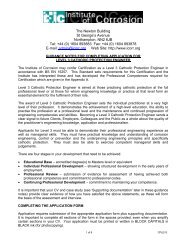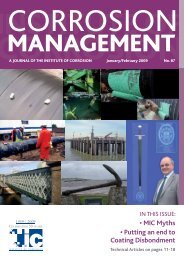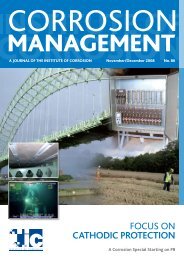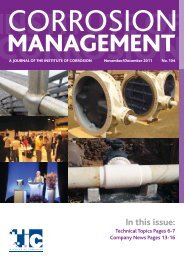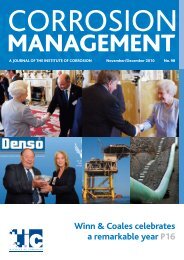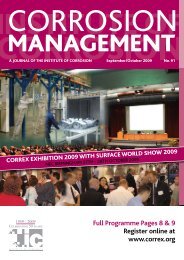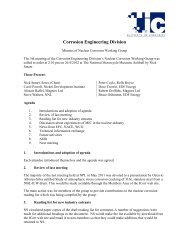<strong>Corrosion</strong>Management | March/April 2012TECHNICALARTICLEsulphide-oxidizing bacteria (SOB), whichin turn convert <strong>the</strong> hydrogen sulphide tosulphuric acid (H2SO4). The oxidation bySOB <strong>of</strong> hydrogen sulfide generated by SOBserves to promote a continuous electrolysisprocess at <strong>the</strong> steel surface. Through <strong>this</strong>symbiotic action <strong>of</strong> collocated colonies <strong>of</strong>SRB and SOB participating in a microbialsulphur cycle, <strong>the</strong> standard rusting, corrosionprocess is accelerated and made moresevere through pitting. It fur<strong>the</strong>r states thatsymobiotic colonies <strong>of</strong> SRB and SOB findacceptable conditions at <strong>the</strong> tidal interface,where both anaerobic conditions for <strong>the</strong> SRBand oxygen availability for <strong>the</strong> SOB occur.Electrochemical corrosion also requires waterand oxygen. All <strong>the</strong>se conditions are evidentlybest satisfied near low astronomical tide(LAT), being very infrequently exposed in <strong>the</strong>tidal range. There appears to be a 0.5m heightrange <strong>of</strong> susceptibility above LAT, hence<strong>the</strong> terminology <strong>of</strong> accelerated low watercorrosion.2.1.3.4.3 Immersed andEmbedded Zones<strong>Corrosion</strong> in <strong>the</strong> immersed zone is relativelyslow and uniform (Figure 8) and in many cases<strong>the</strong> structure could be passivated by corrosionby-products or marine growth. Exceptioncan occur at bed level, where concentratedcorrosion caused by differential oxygen cells,by scouring that exposes clean steel or <strong>the</strong>presence <strong>of</strong> soil-borne SRB 3 .Where <strong>the</strong> structure is below <strong>the</strong> seabedlevelvery little corrosion occurs as <strong>the</strong>re is nooxygen and <strong>the</strong> rate given for <strong>the</strong> corrosionbelow seabed level is 0.05mm per year 13 .However if <strong>the</strong>re is coarse granular materialwhere oxygen traces are present, corrosionwill occur but it is slow and uniform except if<strong>the</strong> soil is acidic or contains SRB.2.1.4 Methods forControl and Prevention <strong>of</strong><strong>Corrosion</strong> in Marine SteelStructuresWhen it comes to design <strong>of</strong> preventivemeasures for corrosion <strong>of</strong> carbon steel inmarine environment, <strong>the</strong>re is no clear cutapproach in corrosion industry to overcome<strong>the</strong> corrosion. How much protection isrequired is still debatable, <strong>the</strong> reasonbeing that <strong>the</strong> corrosion <strong>of</strong> steel in marineenvironments, sometimes difficult to relateto field conditions and hence not easilytransportable to o<strong>the</strong>r situations 38 . Hence<strong>the</strong> designer normally relies on operatorsown guidelines (based on <strong>the</strong>ir operationaland maintenance experiences) or variousspecialist publications that provide guidelines for corrosion protection 39 . On majorresources projects <strong>the</strong> 1 st author has followed<strong>the</strong> operator’s more strenuous guidelineon <strong>the</strong> corrosion protection ra<strong>the</strong>r than <strong>the</strong>code requirement (Figure 9). The followingcorrosion protection coating system wasapplied from -2mCD to top <strong>of</strong> piles, and allprimary and secondary steelwork for marinestructure in Port Hedland:n Prime Coat <strong>of</strong> <strong>In</strong>tergard 269;n Top coat <strong>of</strong> <strong>In</strong>terzone 954 applied by airlessspray, two coats (wet on dry), tinted forvisual differentiation;n Total topcoat <strong>of</strong> DFT 500 microns; andn Colour N35 light grey as a final topcoatfor piles.Impressed current cathodic protection is alsoinstalled on piles to minimise maintenanceand disruption <strong>of</strong> jetty loading operationsduring its design life 40 .ALWA is a concern for designers because <strong>the</strong>corrosion rates can be at least a factor <strong>of</strong>10 times faster than average level corrosionresulting in a potential failure in less than 10years 29 and a novel form <strong>of</strong> naturally occurringcoating that could mitigate <strong>the</strong> corrosiondamage to existing structures called “LATreat”has recently been proposed 29 . <strong>In</strong> brief, <strong>this</strong>is a three stage protection on an existingstructure:The first stage <strong>of</strong> <strong>the</strong> three-step processinvolves surface cleaning and removal <strong>of</strong>Figure 9. <strong>Corrosion</strong> coating system for piles <strong>of</strong> <strong>the</strong> HarrietPoint Loading Platform Jetty, showing marine growth intidal zone (Image courtesy <strong>of</strong> Mac Connell Dowell).deposits via an applied voltage to <strong>the</strong> structure.Through <strong>this</strong> step, hydrogen is evolved from<strong>the</strong> surface – <strong>this</strong> helps to dislodge and remove<strong>the</strong> corrosion and associated bi<strong>of</strong>ilm;The second phase involves a voltage reversal,where chlorine is directly generated on <strong>the</strong>surface structure by salt water electrolysis.Once <strong>the</strong> chlorine has reached a significantconcentration (a few parts per million), it killslocal bacteria and o<strong>the</strong>r microbial agents bysterilisation. It is said that it is a similar processto <strong>the</strong> chlorination <strong>of</strong> swimming pools – i.e.direct electrolysis <strong>of</strong> salt solution to producechlorine; and<strong>In</strong> stage three, <strong>the</strong> applied voltage polarityis reversed again, reverting to <strong>the</strong> initial phase.The current flow, however, is controlled to amuch lower value and is pulsed on and <strong>of</strong>f.<strong>In</strong>stead <strong>of</strong> hydrogen, water is reduced directlyby electrolysis and produces alkali locally at<strong>the</strong> structure surface.It is reported that if <strong>the</strong> pH is altered andraised (such as by <strong>the</strong> production <strong>of</strong> alkali),<strong>the</strong> solubility <strong>of</strong> calcium bicarbonate (asseawater is a dilute solution <strong>of</strong> CO 2 in <strong>the</strong>form <strong>of</strong> calcium bicarbonate) reduces and afilm <strong>of</strong> calcium carbonate is deposited. Thecoating, consisting <strong>of</strong> calcium carbonateand magnesium hydroxide is deposited by asimilar mechanism, as it is naturally layeredby <strong>the</strong> pulsed nature <strong>of</strong> <strong>the</strong> current.Due to all <strong>the</strong> uncertainty that surrounds<strong>the</strong> following precautions should be followedas part <strong>of</strong> <strong>the</strong> design in order to achieve <strong>the</strong>intended design life :n Use <strong>of</strong> a heavier sectionn Use <strong>of</strong> high yield steel at mild steel stresslevelsn Application <strong>of</strong> Coating System; andn Application <strong>of</strong> Cathodic Protection; orn Combination <strong>of</strong> all aboveAlthough all <strong>the</strong> above can be used separatelyor in combination to prevent general corrosion 1& 41<strong>the</strong> only preventive action that will delayor minimise localised corrosion is <strong>the</strong> “Designfor durability and good detailing”.2.1.5 What is design fordurabilityBy understanding <strong>the</strong> corrosion mechanism(as also outlined above), <strong>the</strong> design fordurability and good detailing stands at <strong>the</strong>core <strong>of</strong> corrosion control <strong>of</strong> <strong>the</strong> marine steelstructure. The aim in <strong>the</strong> design should beto prevent <strong>the</strong> formation <strong>of</strong> corrosion cells24
TECHNICALARTICLEFigure 10. Typical detail <strong>of</strong> providing good drainage to prevent commencement <strong>of</strong> corrosion cells (Image courtesy<strong>of</strong> Mac Connell Dowell)which are <strong>the</strong> catalyst for commencement<strong>of</strong> corrosion. For example if we can eliminate<strong>the</strong> formation <strong>of</strong> <strong>the</strong> electrolyte on <strong>the</strong>structures, <strong>the</strong>n <strong>the</strong> commencement <strong>of</strong>corrosion will be delayed. This means that<strong>the</strong> structural detailing should be in such away:n To maintain adequate space betweencomponents to facilitate corrosionprotection painting system to be applied;n To avoid formation <strong>of</strong> pools <strong>of</strong> water inparts <strong>of</strong> <strong>the</strong> structure at all time;n To ensure good drainage <strong>of</strong> water on steelmembers at all time;n To fully seal hollow sections;n To avoid placing steel members so <strong>the</strong>yare inaccessible for inspection; andn To insulate two metals from each o<strong>the</strong>r iftwo different metals are used in <strong>the</strong>design.Hence eliminating <strong>the</strong> formation <strong>of</strong> corrosioncells. The design should be based on <strong>the</strong>“eliminate <strong>the</strong> corrosion cells principle”.additional plate (see Figure 10) to providea sloped drainage system to eliminate <strong>the</strong>creation <strong>of</strong> corrosion cells in that area.Example 2Figure 11 shows detailing that providesgood drainage and adequate space betweencomponents to facilitate corrosion protectionpainting or galvanising;Example 3The detailing <strong>of</strong> <strong>the</strong> catwalk bottom nodesat an LNG/LPG jetty (i.e. bottom structuralchords intersect) was such that pondingwould have occurred. Hence “Megapoxy P1”was used (Figure 12) to eliminate <strong>the</strong> pondinghence elimination <strong>of</strong> corrosion cells.“Megapoxy P1” is a two component highstrength epoxy paste based on DGEBA epoxyresin and carbonate free filler. Easy to use,<strong>this</strong> product sets after mixing with excellentproperties for a wide range <strong>of</strong> applicationssuch as metal to metal bonding.Figure 11. Typical detail <strong>of</strong> providing good drainageto prevent commencement <strong>of</strong> corrosion cells (Imagecourtesy <strong>of</strong> Clough)3.0 ConclusionThis study has looked at a case study to showhow a design life <strong>of</strong> 50 years for steel marinestructures in a severe marine environmentin terms <strong>of</strong> corrosion can be achieved. Thestudy has shown that, corrosion affecting<strong>the</strong> durability <strong>of</strong> marine structures is ra<strong>the</strong>r acomplex phenomenon and <strong>the</strong>re is no singleapproach to <strong>the</strong> corrosion prevention <strong>of</strong>marine structures. An effective approach tocorrosion prevention is a combination <strong>of</strong> <strong>the</strong>following:1. Understanding <strong>of</strong> mechanism <strong>of</strong> corrosionand corrosion <strong>issue</strong>s;2. <strong>In</strong> <strong>the</strong> case <strong>of</strong> carbon steel marinestructures:n good detailing;n <strong>of</strong>fsite fabrication with good qualitycontrol; andn application <strong>of</strong> an appropriate coatingsystem that forms an impregnating typebarrier against <strong>the</strong> passage <strong>of</strong> seawater to<strong>the</strong> surface <strong>of</strong> <strong>the</strong> carbon steel structure.The common factor in all <strong>the</strong> above is <strong>the</strong>“prevent <strong>the</strong> formation <strong>of</strong> corrosion cellprinciple” which relies on <strong>the</strong> designer havingan understanding and awareness <strong>of</strong> <strong>the</strong>mechanism <strong>of</strong> corrosion and corrosion cellformation. The designer must consider <strong>the</strong>“prevent <strong>the</strong> formation <strong>of</strong> corrosion cellThe following are some examples <strong>of</strong> structuraldetails based on idea <strong>of</strong> “eliminate <strong>the</strong>corrosion cells principle”:Example 1The design was such that <strong>the</strong> top <strong>of</strong> <strong>the</strong> pile asshown in Figure 10 was sloped, hence <strong>the</strong> seawater would have been pooled and corrosioncell. The detail was modified by welding anFigure 12. Typical detail <strong>of</strong> prevention <strong>of</strong> ponding and corrosion cell (Image courtesy <strong>of</strong> Woodside)25



